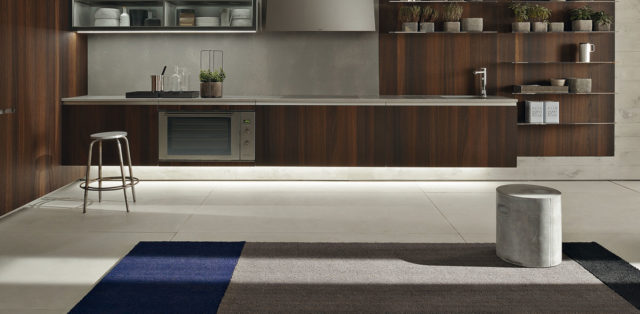Before we go into what laminate is exactly, we’ll quickly recap on what timber veneer is (if you want a more detailed explanation read our previous blog). Often the word veneer gives some people the impression something is fake. That is not the case, timber veneer is real timber, just a very thin slice of a log. This thin slice of timber is applied to a substrate giving the look of solid wood without the cost. Making timber into veneer is the most efficient use of a log, with one cubic metre of timber producing approximately 1,000 square metres of veneer.
Timber veneer is not the only product in the marketplace that can be used as an overlay on a substrate, but it is the most natural. Laminate is a synthetic alternative made from paper and plastic resins. To produce laminate two layers of paper, with one typically decorated, are soaked in different resins to make them hard and brittle before they are hard-pressed together to form a laminate sheet. Given its artificial nature, laminate can be manufactured in a vast array of decorative colours and patterns. Ironically, people often choose laminates that look like timber.
Most people are used to seeing laminate used in the context of benchtops, however, it can be used for vertical applications as well, such as kitchen cabinetry and furniture. Laminate flooring has also become increasingly popular. One of the biggest draw cards with laminate is its lower costs due to the fact it is made from paper and plastic.
From an environmental perspective, timber veneer is the better, greener choice. Our timber is sourced from sustainably managed forests, which means we are using a renewable resource. Laminates are manufactured using resin (i.e. plastic) and like most things made from such materials are not necessarily straightforward to recycle or dispose of properly.
The one key strength laminate has over veneer is also its biggest limitation. In some instances, designers, architects and end-users are drawn to the consistency of laminate, mainly in fear of the natural variation that occurs more often when using a natural material, such as timber veneer. However, when laminates are used the final product tends to be too uniform, appearing man made and lacking character and warmth. Whereas with timber veneer, you can be sure the finished project can never be exactly repeated again, ensuring your designs are authentic and bespoke.
If consistency is key, a better option to laminate might be an engineered wood product, like our Truewood range. Engineered veneer is wood that has been subjected to manufacturing processes but is essentially real wood taken in strand, particle or fibre form and mixed with adhesives to create a composite wood material. So the end product still contains real wood but it has other materials “mixed in”. Engineered wood offer more consistency in terms of colour and grains. The colour and feel of a precious natural timber can also be better replicated by an engineered veneer than a laminate.
Choosing an overlay for a substrate is a personal choice, but from our perspective you cannot go past timber veneer, made from either natural or engineered wood. Timber’s natural beauty might be replicated but it cannot be equalled. Timber veneer is real timber that injects warmth and class in the contexts it is used. Laminate might offer a dazzling array of choices, but it generally delivers an aesthetic that is decidedly fake owing to its synthetic roots.



